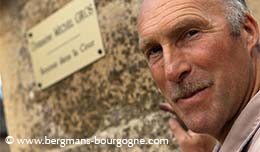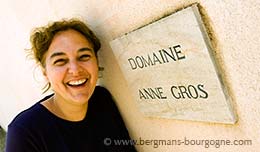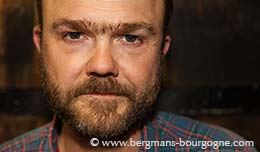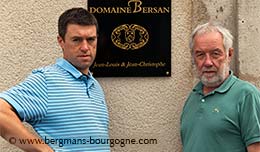
los Napoléon in Fixin has a peculiar history. Named after the French emperor this premier cru has been a monopole for a very long time. It has doubled as an orchard, dynamite has been used when replanting and soil is almost nonexistent there.
– It has been a monopole of the domaine since the 1950s, says Pierre-Emmanuel Gelin. It was replanted in 1955-1956. At the time it was only half a hectare, at the bottom of the clos. My grandfather cleared the upper part, removed all the fruit trees, from the restaurant up to Clos de la Perrière.
Originally the Clos Napoleon was the brainchild of Claude Noisot (1787-1861), an officer of Napoleon’s Imperial Guard. His wife owned vineyards, among them two plots in the clos making up one third of its total surface area. At the time the name of the lieu-dit, Aux Cheuzots, was used. Claude Noisot set out to buy the remaining parts and then renamed it Clos Napoléon.
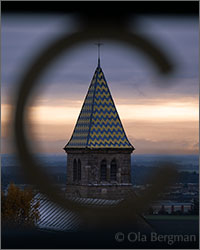 – I’m the third generation here, says Pierre-Emmanuel Gelin. My grandfather Pierre created the domaine in 1925. My dad arrived here in 1969. There were not any vineyards in the family before my grandfather. He started out renting vineyards. Later he bought them.
– I’m the third generation here, says Pierre-Emmanuel Gelin. My grandfather Pierre created the domaine in 1925. My dad arrived here in 1969. There were not any vineyards in the family before my grandfather. He started out renting vineyards. Later he bought them.
Back in his day Pierre Gelin was quite a visionary. While others preferred quantity over quality he saw it differently. He was the first winegrower of the family. Initially he rented vineyards, which he eventually bought. He had quite a lot of vineyards at the bottom of the village, vineyards which were high-yielding. But given the preferences of the time he could swap these for lower-yielding vineyards higher up the slope, such as the Clos Napoléon.
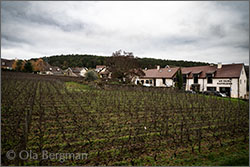 – That was how he managed to create the domaine, with nice appellations, back when quantity was what everyone was looking for. Much of the production was aimed for local consumption in Dijon. He basically created the whole domaine. Then parts were lost as the generations changed. Initially it was 17 hectares. Then it shrunk to ten hectares and it is now twelve and a half.
– That was how he managed to create the domaine, with nice appellations, back when quantity was what everyone was looking for. Much of the production was aimed for local consumption in Dijon. He basically created the whole domaine. Then parts were lost as the generations changed. Initially it was 17 hectares. Then it shrunk to ten hectares and it is now twelve and a half.
– There is very little soil in the clos. Just a few centimers of soil. The bedrock is very close to the surface. My grandfather used dynamite when he replanted. We can still see the rock in places. We replanted a small part in 2015, below the parking of the restaurant next to the street. There were many large rocks and we got the authorisation from the INAO to crush the rocks and put the soil back on top.
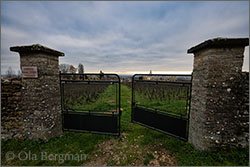 – There are two types of rock in Clos Napoléon. One brown and one white, which is typical for Clos Napoleon. At the bottom there is quite thick clay. Thanks to this you get a nice complexity between minerality and power. It’s a wine which is very good for aging. You have a complexity with a floral side, tobacco and leather. We use 20 per cent new oak. There is a touch of smoked character. People tend to think it is from the barrels, but it is not. It is the terroir.
– There are two types of rock in Clos Napoléon. One brown and one white, which is typical for Clos Napoleon. At the bottom there is quite thick clay. Thanks to this you get a nice complexity between minerality and power. It’s a wine which is very good for aging. You have a complexity with a floral side, tobacco and leather. We use 20 per cent new oak. There is a touch of smoked character. People tend to think it is from the barrels, but it is not. It is the terroir.
Three quarters of the Domaine Pierre Gelin vineyards are in Fixin and one quarter in Gevrey-Chambertin. The absolute majority of the vineyards is pinot noir. There is very little white wine at this address. Some of the village appellation Fixin was replanted with chardonnay in 2022.
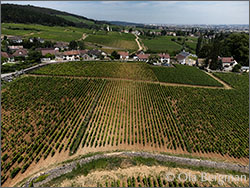 – Before that I made one barrel of white Fixin. That was all. It is a very small vineyard below the church in Fixey. In 2021 I didn’t make any at all.
– Before that I made one barrel of white Fixin. That was all. It is a very small vineyard below the church in Fixey. In 2021 I didn’t make any at all.
The red village appellation Fixin is a considerably larger cuvée. It is a blend from ten different parcels.
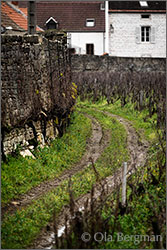 – They are all over Fixin, from the four corners of the village, says Pierre-Emmanuel Gelin. But mainly middle and southwest. In many cases there is a lot of clay and there are the ones with more limestone, which will add minerality. In addition to that you have the impact of the terroir, the corpulent character. The vines are quite old, average 50-60 years. There are hardly any young vines. The élevage is quite long, about 20 months. I use 30 % whole bunches.
– They are all over Fixin, from the four corners of the village, says Pierre-Emmanuel Gelin. But mainly middle and southwest. In many cases there is a lot of clay and there are the ones with more limestone, which will add minerality. In addition to that you have the impact of the terroir, the corpulent character. The vines are quite old, average 50-60 years. There are hardly any young vines. The élevage is quite long, about 20 months. I use 30 % whole bunches.
When Pierre-Emmanuel Gelin arrived at the domaine in 2001 it was all traditional wine growing. Weedkillers were used and there was no ploughing. Since then much has changed. Domaine Pierre Gelin is organic since 2015 and certified organic since 2019.
– My impression is that we have had the desired results, says Pierre-Emmanuel Gelin. But unfortunately we have also had changes in the climate at the same time. We have many sunny vintages. It’s a bit deceptive, because there is a lot of intensity and expression in the wines. We need more vintages, more diverse vintages, before we can judge the results. Before 2015 we had quite heterogeneous vintages, whereas since then they have been concentrated with luxuriant aromas.
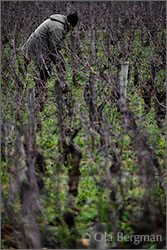 The other Fixin premier cru of the domaine, Les Hervelets, was where the use of whole bunches at Domaine Pierre Gelin started. You’ll find Les Hervelets and its sibling premier cru, Les Arvelets, at the top of the slope between Fixin and Fixey. Les Arvelets may be bottled as Les Hervelets, but not the other way around.
The other Fixin premier cru of the domaine, Les Hervelets, was where the use of whole bunches at Domaine Pierre Gelin started. You’ll find Les Hervelets and its sibling premier cru, Les Arvelets, at the top of the slope between Fixin and Fixey. Les Arvelets may be bottled as Les Hervelets, but not the other way around.
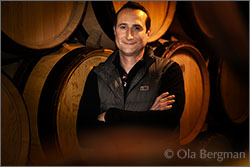 – I started with whole bunches in 2015, so there has been a change aromatically since then, explains Pierre-Emmanuel Gelin. I use 20 per cent new oak. Les Hervelets is a terroir with well-integrated tannins. A bit more delicate than the others in Fixin. Our bottling is a blend of Les Arvelets and Les Hervelets. We have a very small plot in Les Arvelets and one large in Les Hervelets, where we are in the hollow, the Meix Bas lieu-dit behind the restaurant. It was not originally classified as premier cru, but was included in Les Hervelets around 1970-1980. This is a terroir which has benefitted from the climate change. It is a hollow, and with the cool wind from the valley up behind it was difficult for the grapes to ripen in the past. Thats why I blend it with the Les Arvelets. Today the grapes always ripen.
– I started with whole bunches in 2015, so there has been a change aromatically since then, explains Pierre-Emmanuel Gelin. I use 20 per cent new oak. Les Hervelets is a terroir with well-integrated tannins. A bit more delicate than the others in Fixin. Our bottling is a blend of Les Arvelets and Les Hervelets. We have a very small plot in Les Arvelets and one large in Les Hervelets, where we are in the hollow, the Meix Bas lieu-dit behind the restaurant. It was not originally classified as premier cru, but was included in Les Hervelets around 1970-1980. This is a terroir which has benefitted from the climate change. It is a hollow, and with the cool wind from the valley up behind it was difficult for the grapes to ripen in the past. Thats why I blend it with the Les Arvelets. Today the grapes always ripen.
The village appellation Gevrey-Chambertin, the Clos de Meixvelle, comes from a vineyard right in the middle of the village. As the name suggests it is surrounded by walls.
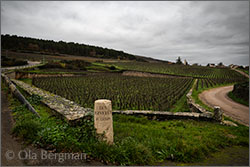 – There are walls four metres high, says Pierre-Emmanuel Gelin. It really is a microclimate. It is surrounded by houses and the wall, so it’s very well-protected. There is some wind, but during the summer it is very warm. There is alluvial soil since it’s the extension of the valley. The soil is not very deep. There is some limestone. Clos de Meixvelle produces a Gevrey-Chambertin which is quite elegant.
– There are walls four metres high, says Pierre-Emmanuel Gelin. It really is a microclimate. It is surrounded by houses and the wall, so it’s very well-protected. There is some wind, but during the summer it is very warm. There is alluvial soil since it’s the extension of the valley. The soil is not very deep. There is some limestone. Clos de Meixvelle produces a Gevrey-Chambertin which is quite elegant.
The Gevrey-Chambertin premier cru Clos Prieur is below Mazis-Chambertin.The berries are always millerandé which concentrates the character of the resulting wine, a character which is similar to its grand cru neighbour. The wine sees 50 per cent new oak. Five barrels are produced in a good year.
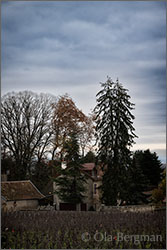 Chambertin Clos de Bèze is the only grand cru of Domaine Pierre Gelin.
Chambertin Clos de Bèze is the only grand cru of Domaine Pierre Gelin.
– We have two parcels. One almost at the beginning and one at the end. I don’t really know if they are different since I always have vinified them together. One is younger, planted in 2000. The other 70 years. The soil is very much the same. I use 80 per cent new oak for this wine.
Pierre-Emmanuel Gelin may have seen some major changes at the domaine, but they have been very much in line with previous generations. The tools are different, but the goals are the same.
– It is very much the same thing, same spirit. Maybe with a little less precision. I have been lucky to have better equipment. The old premises, the old building next to the church, weren’t ideal. There was just air-conditioning if you needed to cool down the wine. Today we have temperature-regulated tanks, pneumatic punchdown etc. Everything is much easier to control. He started to focus on finesse. That was his goal in the same way it is for me. Fixin is a bit rustic, so we are trying to have a Fixin as delicate as possible. My father started to work with cooling quite early. Already in 1995. I began with whole bunches in search for finesse, I felt there was something missing mid-palate.
– Fixin has been known for being rustic. The harshness of the terroir would sometimes give animal aromas. It was thought of as being part of the terroir.
– Obviously you have to keep the character of the terroir. Fixin are wines to cellar. But maybe you can produce a wine which can be drunk a little bit earlier. I have the same way of working as my grandfather. Two years élevage in barrel. The wines come on the market the fourth year. To take the hard edges off the terroir is what we strive for.
© 2025 Ola Bergman










